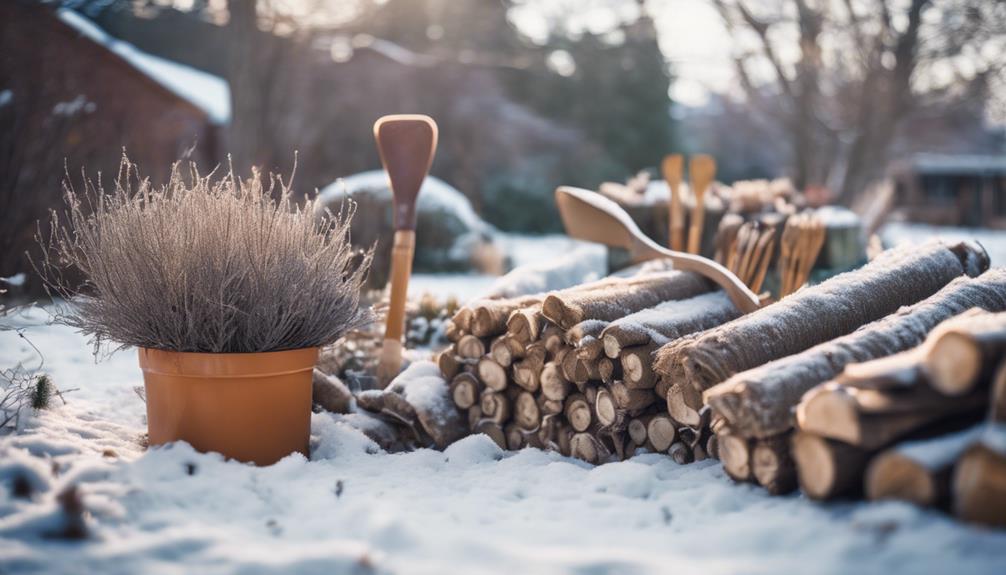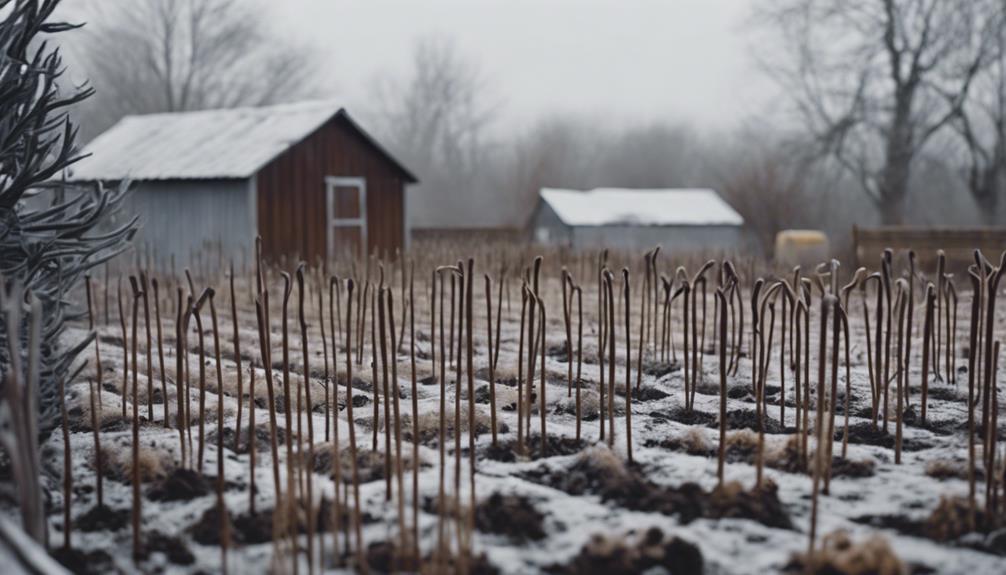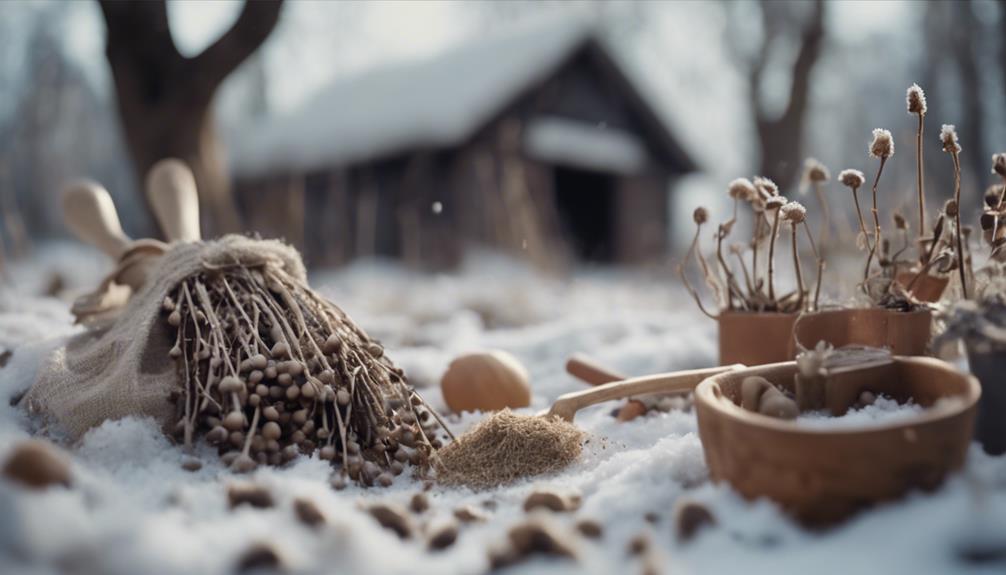
Winter Garden Preparation Harborne
27 November 2024
Winter Garden Preparation Selly Oak
27 November 2024Preparing Your Winter Garden in Quinton
As the chill of winter approaches, it's time to roll up your sleeves and get your garden ready for the colder months. Clearing away debris is your first order of business. Leaves, dead plants, and other materials can become a breeding ground for pests and diseases if left unattended. Think of it as a spring clean for your garden—out with the old to make way for the new!
Pruning and Maintenance
Next up, prune perennial plants down to soil level. This not only tidies up the look of your garden but also encourages healthier growth come springtime. And don't forget about your gutters! Keeping them clear ensures proper drainage, preventing water from pooling and causing root rot in your beloved plants. A quick check can save you a lot of hassle later on.
Protecting Delicate Species
Now, if you've got any delicate species in your garden, it's time to show them a bit of TLC. Wrapping them in burlap or frost cloths can provide the extra warmth they need to survive the frosty nights. It's like tucking them in for a good night's sleep!
Mulching and Planting
Applying a layer of mulch will help retain moisture in the soil, which is particularly important during dry winter spells. Not only does it keep your plants cosy, but it also suppresses weeds that can pop up when the weather turns milder.
If you're feeling adventurous, consider planting winter-blooming varieties such as hellebores or snowdrops. These hardy flowers can add a splash of colour to your garden, brightening up those dreary winter days. Imagine stepping outside to see pops of white and pink—what a treat!
Assessing Soil Health
Before you put your trowel down for the season, take a moment to assess the health of your soil. Testing it can reveal nutrient deficiencies that you can amend now, ensuring a nutrient-rich environment for your plants in the spring. Think of it as giving your garden a boost of vitamins!
Wrapping Up
These foundational steps will set you on the right path to a thriving garden when spring rears its head. So, grab your gardening gloves, and let's get to work! If you have any questions or need further tips for your winter gardening adventure, feel free to reach out—I'd love to help!
Happy gardening, and here's to a blooming spring ahead!
Essential Winter Garden Tasks

Essential Winter Garden Tasks: Preparing for the Chill
As the temperatures dip and frosty mornings become the norm, it's time to give your garden the attention it deserves for the winter months ahead. A little preparation now can make all the difference come spring. So, grab your gardening gloves and let's dive into some essential winter tasks that will keep your outdoor space tidy and your plants protected.
Clear the Clutter
First things first, tidy up your garden! During November and December, take a stroll through your outdoor sanctuary and clear away any debris. This includes fallen leaves, twigs, and any unwanted plants. Compost what you can—after all, one gardener's rubbish is another gardener's gold! Not only will this keep your garden looking sharp, but it also prevents pests and diseases from overwintering.
Prune with Purpose
Next on the agenda is cutting back perennial plants. Snip them down to soil level to safeguard them against winter's harsh embrace. This not only protects them from damage but also encourages vibrant growth when spring rolls around. Think of it as giving your plants a well-deserved rest and a fresh start!
Insulate Your Greenery
For those delicate plants that can't handle the chill, insulation is key. Consider applying a thick layer of mulch around their base to keep their roots warm. For young trees and shrubs, wrapping them in burlap or fleece can provide that extra layer of protection from biting winds. It's like dressing them in a cosy winter coat!
Keep the Pathways Clear
Let's not forget about your lawns and pathways. Rake or blow leaves off these areas to prevent decay, which can lead to unsightly patches come spring. No one wants to be tripping over a carpet of soggy leaves! Additionally, ensure that your drains and gutters are clear to prevent any waterlogging issues. A clean garden is a happy garden!
Turn Your Compost
Now, if you've been diligently composting, it's time to turn that pile. This action ensures that your organic matter breaks down properly, resulting in rich compost that will nourish your plants when spring arrives. It's like giving your garden a little boost of energy after its winter slumber!
Add Some Seasonal Cheer
Lastly, why not consider planting winter-flowering plants? These beauties can add a splash of colour to your garden during the dreary months. Think of hellebores or winter jasmine to brighten up those grey days. Your garden will thank you for the seasonal interest, and you'll feel a sense of joy each time you step outside.
Conclusion: Get Started!
Pruning and Maintenance Tips
Pruning and Maintenance Tips for a Flourishing Garden
As winter approaches, it's the perfect time to shift your focus towards pruning and maintenance. Not only will this tidy up your garden, but it will also set the stage for healthy plant growth come spring. So, let's roll up our sleeves and dive into some essential tips!
Clear the Decks: Uproot Annual Flowers
First on the agenda is to uproot those annual flowers. This simple act clears away debris and keeps your garden clean and manageable throughout the winter months. Think of it as giving your garden a fresh start—like a spring clean, but for your plants!
Prune Your Roses: A Winter Ritual
Now, let's talk roses. Come January or February, it's time to prune these beauties. Focus on removing any dead or diseased stems. This is crucial for promoting robust growth when the warmer weather returns. A well-pruned rose bush is like a well-tuned piano; it will produce stunning blooms once the season changes.
Keep Your Garden Tidy: Clear Leaves and Debris
Don't forget to clear leaves from lawns and paths! It may seem tedious, but neglecting this can lead to decay and, eventually, damage to your plants. Plus, a tidy garden is a happy garden. Imagine strolling through a beautifully maintained space—there's nothing quite like it!
Protect Perennials: Cut Back for Winter
When it comes to perennial plants, cut them back to soil level. This protects sensitive species from frost and helps reduce soil erosion. Think of it as tucking them in for a long winter's nap, ensuring they wake up refreshed and ready to thrive in spring.
Prevent Waterlogging: Maintain Drains and Gutters
Lastly, regularly check and clear your drains and gutters. This may seem like a chore, but it's vital for preventing waterlogging. A well-maintained garden environment is crucial for a thriving ecosystem. Trust me, your plants will thank you come spring!
Take Action Now!
So there you have it—simple yet effective tips to keep your garden in tip-top shape during the winter months. Don't wait until spring to start planning! Grab your gardening gloves and tackle these tasks now. Your future self (and your plants) will be grateful. If you have any questions or need further guidance, feel free to reach out!
Happy gardening! ��
Protecting Tender Plants

Protecting Tender Plants: Essential Winter Care Tips
As winter creeps in, the stakes are high for our tender plants. Protecting them during these colder months is crucial for ensuring their survival and vitality when spring arrives. Let's delve into how you can give your precious greenery the best chance of thriving.
Assessing Plant Needs
First things first, take a good look at your plants. Each species has unique requirements, and some may need a bit more insulation than others. For instance, delicate varieties like fuchsias and geraniums might benefit from extra protection compared to more resilient plants. It's like knowing which friend needs a warm coat and which one is fine in a light jacket!
Handy Protective Measures
A fantastic way to keep your plants snug is by using burlap wraps or frost cloths. These materials work wonders by shielding your plants from biting winds and plummeting temperatures. Think of it as wrapping your plants in a cozy blanket. If you don't have burlap handy, old sheets or even cardboard can do the trick in a pinch.
Don't forget about mulch! A thick layer around the base of your plants can help regulate soil temperature and lock in moisture. It's the plant equivalent of a warm pair of socks on a chilly night.
Container Plants: A Different Approach
If you have container plants, they might need a bit of extra love. Relocating them to a sheltered spot, like a porch or garage, can prevent root damage from frost. If space allows, bringing them indoors is ideal; just be sure to give them a good drink before their indoor holiday!
Stay Vigilant
Keep an eye on your plants throughout the winter. Look for signs of distress, such as drooping leaves or discoloration. This is your cue to adjust your care routine. After all, even plants can have a rough day! Regular checks can help you catch problems before they escalate.
Wrapping It Up
By implementing these simple yet effective strategies, you can ensure that your tender plants not only survive the winter but are ready to burst back into life when the growing season comes around. Remember, a little preparation goes a long way. So why not grab that burlap and give your plants the winter care they deserve? Your garden will thank you come spring!
If you're looking for more tips or need personalised advice, feel free to reach out. Let's keep those green thumbs thriving!
Winter Plant Options
Enliven Your Winter Garden: Plant Choices for Quinton
When the chill of winter settles in, many gardeners may feel a tinge of despair, believing their beloved gardens have succumbed to the cold. Fear not! With the right winter plants, you can transform your outdoor space into a vibrant oasis, even in the frostiest months. Let's dive into some splendid options that will keep your garden looking lively in Quinton.
Snowdrops: A Classic Winter Bloomer
First up, we have the charming snowdrop. These delicate white flowers bloom between January and March, bravely breaking through the frost. They're like tiny harbingers of spring, bringing a breath of fresh air to winter's dreariness. Plant them in clusters for a more impactful display, and you'll soon find yourself enchanted by their ethereal beauty.
Crocuses: A Splash of Colour
Next, consider the crocus. These cheerful little bulbs come in a variety of colours, ranging from vibrant purples to sunny yellows. Ideal for planting in containers or beneath trees, crocuses can brighten up even the gloomiest of days. Imagine sipping your morning tea while gazing at these beauties peeking through the snow—pure bliss!
Winter Aconites: Golden Gems of the Garden
If you're looking for something truly eye-catching, winter aconites should be on your radar. With their striking yellow flowers, they're perfect for naturalising in lawns, creating a carpet of sunshine that defies the winter gloom. These plants have a knack for bringing warmth and joy to your garden—think of them as little golden gems nestled in the grass.
Hellebores: The Regal Winter Roses
Let's not forget about the hellebore, also known as the winter rose. This elegant plant offers shades ranging from creamy whites to deep purples, enriching your winter palette with sophistication. They thrive in partial shade, making them ideal for those tricky spots in your garden that need a touch of glamour.
Cyclamen and Winter Violas: Foliage and Fragrance
For added texture and fragrance, look no further than cyclamen and winter violas. Cyclamen boasts heart-shaped foliage that adds a lush feel to your garden, while winter violas bring delightful blooms with a sweet scent. These plants are like the little finishing touches that elevate your garden from ordinary to extraordinary.
Embrace the Beauty of Winter Gardening
Incorporating these winter plants into your garden design not only enhances its visual appeal but also demonstrates the beauty of seasonal gardening. So, why not embrace the chill? Grab your gardening gloves, and get planting! Your winter garden awaits, ready to dazzle and delight.
If you'd like more tips or specific product recommendations, feel free to reach out. Let's make this winter the most enchanting one yet!
Preparing for Spring Gardening

Kickstart Your Spring Gardening Adventure
A well-prepared garden in early spring is like laying the groundwork for a successful performance. Just as a conductor ensures every musician knows their part, you too must set the stage for your plants to flourish throughout the growing season.
Assessing Your Soil Health
First things first, let's talk about the soil—the very heart of your garden. Conducting a soil test is akin to getting a health check-up; it reveals crucial information about pH and nutrient levels. Armed with this knowledge, you can amend your soil with organic matter, transforming it into a nutrient-rich haven for your plants. Think of it as giving your garden a nourishing meal!
Clearing the Clutter
Next up, roll up those sleeves and clear away any debris and weeds. Just like tidying up your living room before guests arrive, this step eliminates unwanted competition for nutrients. A clean slate allows your plants to stretch their roots and soak up all the goodness you've prepared.
Pruning for Prosperity
Now, let's not forget about pruning. Dormant perennials and shrubs need a little TLC to encourage vigorous growth. Pruning not only helps in shaping your plants but also ensures proper air circulation. After all, nobody likes a stuffy room, right?
Embrace Crop Rotation
If you're looking to take your gardening game up a notch, consider crop rotation. This practice prevents soil depletion and keeps pesky pests at bay. It's like rotating your wardrobe seasonally—giving each plant its turn in the spotlight while keeping the soil vibrant and healthy.
Choosing the Right Plants
When it comes to selecting seeds or transplants, be mindful of your climate. Reading up on ideal planting times is key. You wouldn't wear a winter coat in July, would you? Similarly, ensuring your plants are sown at the right time can make all the difference.
Establishing an Irrigation Plan
Finally, let's chat about irrigation. Think of it as the lifeline for your garden. Establishing a consistent moisture plan is crucial for germination and root development. Whether you opt for a drip irrigation system or a simple watering can, ensuring your plants get the right amount of water is essential.
Wrapping It Up
This meticulous preparation is like setting a solid foundation for a house; it boosts plant vitality and yield throughout the season. So, roll up your sleeves and dive into the wonderful world of spring gardening! Your plants will thank you for it, and before you know it, you'll be reaping the rewards of your hard work. For more tips or advice, feel free to reach out—we're here to help you bloom!
Frequently Asked Questions
When Should You Start Planning Your Winter Garden?
When to Begin Planning Your Winter Garden
Isn't it a bit whimsical to imagine that winter gardens spring up all on their own? The truth is, a successful winter garden doesn't just happen by chance; it requires a bit of foresight and organisation. Ideally, you should kick off your planning in autumn, particularly around November. This is the golden opportunity to clear away any debris from the growing season, which not only tidies up your space but also protects tender plants from the harsh winter chill.
The Importance of Preparation
Why bother with all this preparation, you ask? Well, think of it like getting your house in order before a big party. If you want your garden to flourish come spring, putting in the groundwork now is essential. Clearing debris prevents pests and diseases from overwintering in your garden. Plus, it allows you to assess any plants that might need special care, like mulching or extra insulation from frost.
What to Do in November
So, what exactly should you be doing in November? Here's a handy checklist to get you started:
- Clear the Clutter: Rake up leaves, pull out spent plants, and tidy up any garden tools that have been left lying around. A clean space is a happy space!
- Protect Tender Plants: If you have any delicate plants that won't make it through the winter, consider wrapping them in burlap or using mulch to insulate their roots.
- Plan Your Layout: Take a moment to sketch out your winter garden design. Will you include winter-blooming plants, or perhaps some hardy evergreens? Think about how you want your garden to look in the colder months.
- Stock Up on Supplies: Now's the time to grab any necessary supplies. Whether it's compost for your soil or protective coverings for your plants, making a list and checking it twice will save you time later.
A Little Humour Goes a Long Way
And let's not forget the fun side of gardening! Picture yourself in your wellies, with a cup of tea in one hand and a shovel in the other, ready to tackle whatever winter throws your way. It's a bit like preparing for a British summer; you never quite know what to expect, but a little preparation helps you weather any storm.
Ready, Set, Grow!
In summary, starting your planning in November not only sets you up for a vibrant winter garden but also gives you peace of mind during the chilly months ahead. So, grab your gardening gloves and get to it! The sooner you start, the sooner you can sit back and enjoy the beauty of your hard work when spring arrives.
If you need any assistance or have questions about specific plants or techniques, feel free to get in touch. Happy gardening!
What Do You Do to Your Garden Before Winter?
Essential Garden Maintenance Before Winter
As winter approaches, your garden deserves a little TLC to ensure it emerges vibrant and healthy come spring. Preparing your outdoor oasis doesn't have to feel like a chore; with a sprinkle of care and attention, you can set the stage for a flourishing garden. Here's what you should do before the frost sets in.
Clear Out the Clutter
First things first, clear away debris. Fallen leaves, dead plants, and other detritus can be more than just an eyesore; they can harbour pests and diseases that threaten your plants. Grab a sturdy rake (or a leaf blower, if you're feeling fancy) and clear the ground. Think of it as giving your garden a fresh start, much like a spring clean for your home.
Mulch Like a Pro
Next up, mulching your perennials. A good layer of mulch not only helps retain moisture but also insulates the roots from the harsh winter chill. Opt for organic materials like wood chips or straw – they'll break down over time and enrich your soil. Remember, a well-mulched garden is a happy garden. Just imagine your plants snuggled up under a warm blanket, ready to snooze until spring!
Protect Tender Plants
For those tender plants that can't quite hack the cold, it's time to show them some love. Wrapping them up in horticultural fleece or burlap can provide much-needed protection from frosty bites. If you're feeling particularly generous, consider moving potted plants into a sheltered spot or even indoors. It's like giving them a mini holiday retreat!
Ensure Proper Drainage
Let's not forget about drainage. Poor drainage can lead to waterlogging, which is a recipe for disaster when the temperatures drop. Check your garden's slopes and make sure that water can flow away easily. If necessary, dig channels or create raised beds to keep your plants high and dry. After all, nobody likes soggy feet, not even plants!
Final Thoughts
With these steps, your garden will be well-prepared to brave the winter months ahead. Not only does this maintenance promote health and resilience, but it also saves you time and effort in the spring. So, roll up your sleeves, put on those gardening gloves, and give your garden the care it deserves.
If you have any questions or need more tips, don't hesitate to get in touch! Happy gardening!
How Can I Make My Garden Look Nice in the Winter?
How to Enhance Your Garden's Winter Aesthetics
When winter rolls around, many gardens can look a bit drab and dreary. However, with a few clever additions and a splash of creativity, you can transform your outdoor space into a winter wonderland that is as charming as it is inviting. Here's how to give your garden some winter flair.
Embrace Evergreens
First and foremost, evergreen plants are your best friends during the colder months. Unlike their deciduous counterparts, these hardy plants maintain their foliage, providing a lush backdrop against the stark winter landscape. Consider planting varieties like holly, boxwood, or yew. Not only do they add structure to your garden, but they also bring a pop of colour with their rich, green hues. Imagine stepping out into your garden and being greeted by the vibrant green of a well-placed evergreen—a true breath of fresh air!
Winter-Blooming Flowers
Next up, let's talk about winter-blooming flowers. These little gems can brighten up your garden even when the frost bites. Hellebores, for instance, are often known as Christmas roses, and they thrive in the chill, offering delicate blooms that can last through the season. Another option is winter jasmine, which brings cheerful yellow flowers that can light up a dreary day. Planting these beauties not only enhances visual appeal but also provides food for hungry pollinators that might be out and about.
Ornamental Grasses
Don't underestimate the power of ornamental grasses! These plants can add texture and movement to your winter garden, swaying gracefully in the wind. Varieties like Miscanthus or Pennisetum look stunning when dusted with frost, creating a captivating spectacle. Arrange them in clusters for a more dynamic look, or use them as borders to define pathways. They bring a touch of elegance that can elevate your garden's overall aesthetic.
Keep Pathways Tidy
A tidy garden is a happy garden! Make sure to keep your pathways clear of leaves and debris. This not only improves safety but also enhances the overall appearance. A well-maintained path invites exploration, and you might even find yourself taking a stroll just to admire your handiwork. Add some solar-powered lights along the way to create a warm glow during those long winter evenings.
Add Decorative Elements
Lastly, don't shy away from incorporating decorative elements. Planters filled with seasonal arrangements or quirky garden ornaments can provide that extra touch of whimsy. How about a rustic bird feeder to attract feathered friends? Or a charming bench where you can sit and enjoy a cup of tea while soaking in the beauty of winter? These touches can make your garden feel like a little slice of paradise, even in the chilliest months.
The Bottom Line
Transforming your garden into a winter haven doesn't require a Herculean effort; it simply takes a bit of thought and creativity. So, roll up your sleeves, grab your gardening gloves, and get started! Your garden deserves to shine all year round, and with these tips, you'll be well on your way to creating a winter landscape that is not only beautiful but also welcoming.
If you have any questions or want to share your winter gardening triumphs, feel free to reach out! Happy gardening!
When Should You Tidy Garden for Winter?
When to Tidy Your Garden for Winter
As the leaves begin to fall and the air turns crisp, many gardeners ponder the best time to prepare their outdoor sanctuaries for the chill of winter. The sweet spot for tidying your garden lies between late November and early December. This timeframe isn't just a random guess; it's a strategic window that can significantly enhance the health of your garden.
Why Tidy Up?
You might be wondering, "Why should I bother?" Well, tidying your garden before winter serves several vital purposes. First and foremost, it minimises the risk of disease. Fallen leaves and decaying plants can harbour pests and pathogens, which can wreak havoc in spring. By clearing out this debris, you create a healthier environment for your plants to thrive when the warmer months return.
Furthermore, tidying up protects your plants from the harsh winter frost. Think of it as tucking your plants into bed for the winter. By covering them with mulch or protective coverings, you shield their roots from freezing temperatures, which can be particularly brutal in certain parts of the UK. Trust me, your plants will thank you come spring!
Practical Steps to Take
So, what exactly should you do during this crucial tidying phase? Here's a handy checklist to help you get started:
- Clear Debris: Rake up leaves, trim dead branches, and remove any spent plants. This not only prevents disease but also keeps your garden looking tidy.
- Mulch: Apply a thick layer of mulch around your plants. This acts as an insulator, helping to keep the soil temperature stable and retaining moisture.
- Protect Delicate Plants: For those particularly tender plants, consider using frost cloths or even simple garden fleece to provide an extra layer of warmth.
- Prune Wisely: Now is the time to prune certain shrubs and trees. But be careful! Not all plants benefit from winter pruning, so do your research first.
- Check Tools: Don't forget your gardening tools! Clean and store them properly so they're ready to go when spring rolls around.
A Little Humour Goes a Long Way
Don't let the thought of winter gardening stress you out. Remember, if a plant can survive winter, so can you! Just think of it as a bit of a challenge—like trying to make a proper cuppa without making a mess.
Ready to Get Started?
So, are you ready to give your garden the TLC it deserves before winter hits? Grab your gloves, a sturdy rake, and maybe even a cup of tea (or something stronger, if you prefer), and get to work! The effort you put in now will ensure that your garden bursts back to life with all its glory when the first signs of spring emerge.
For more gardening tips or if you have any questions, feel free to reach out! Happy gardening, and may your green thumb thrive!




